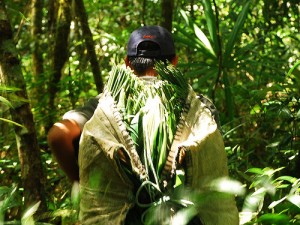A Tale of Two Parks (In One)

Source: Charlie Watson (USAID/Rainforest Alliance Forestry Enterprises) / flickr
Without intending to, the team of civil servants that in 1990 created Guatemala’s Maya Biosphere Reserve (MBR) launched a forest conservation policy experiment. In an ecologically rich region where ranchers and farmers were illegally clearing forests at an astounding clip, they established a huge (two million hectare) protected area with two distinct management regimes—a core protected area where extractive activity is strictly prohibited, and a mixed-use zone where firms and local communities are permitted to harvest timber on the condition that they obtain Forest Stewardship Council certification. Analyzing deforestation in these two zones can help resolve a longstanding debate about tropical forest conservation: how does strict protection perform relative to mixed-use protection?
In principle, each type of regime has advantages and disadvantages. Strict protection prohibits all, instead of just some, extractive activity. However, it is only effective when regulators are willing and able to enforce land cover change restrictions, which is by no means guaranteed in developing countries. In theory, mixed-use protection can sidestep this constraint because it relies more on local organizations to govern land use.
In the MBR, conventional wisdom suggests that mixed-use protection has dramatically outperformed strict protection, because certified community forest concessions in the mixed-use zone have proven able stewards of their forests. In fact, the MBR is often held up as an example of how mixed-use protection and community forestry can be successfully blended.
But the evidence to support this narrative mostly comes from studies that simply compare deforestation rates in mixed-use zone (about two percent from 2001 to 2006) and core protected zone (about five percent) without controlling for the fact that the two zones were sited in places with very different pre-existing risks. These studies are typical of many evaluations of the forest conservation policies based on simple comparisons of deforestation inside and outside areas affected by the policy. Recently, conservation scientists have begun to use matching, regression, and other statistical techniques to generate more rigorous and reliable evaluations.
I used these techniques to examine the performance of mixed and strict protection in the MBR in a new RFF discussion paper. Contrary to the conventional wisdom, I found that mixed-use protection has been only slightly more effective than strict protection. Moreover, I found that the effectiveness of the mixed-use protection is not attributable to the stewardship of certified community forest concessions. Rather, it reflects the strong performance of non-concession land and forest concessions managed by industrial logging companies.
These results highlight the importance of controlling non-random siting in evaluating forest conservation policies. They also add to the thin but quickly growing set of studies making this correction that focuses on the effectiveness of different park management regimes. As a whole, this evidence is quite mixed, suggesting that it is not possible to generalize about which regime is most effective. Rather, place-based factors are determinative. Identifying these factors should be a priority in future evaluations of tropical parks.
About Allen Blackman
Allen Blackman is a senior fellow at Resources for the Future.

 Subscribe; to our RSS Feed
Subscribe; to our RSS Feed Tweets by @RFF_org
Tweets by @RFF_org 